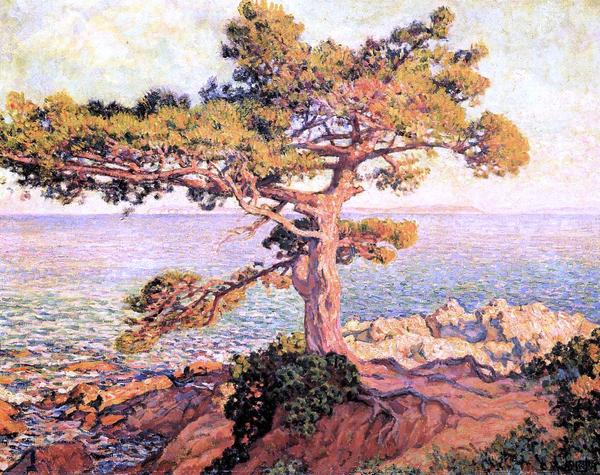A short article on the anarchist painter Theo Van Rysselberghe.

Theodore Van Rysselberghe was born on November 28th 1862 in Ghent, Belgium, to a wealthy family. He studied painting at schools of fine arts in first Ghent and then Brussels. In 1884, he travelled to Spain and Morocco which opened his eyes to the need to depict light in his paintings.
Returning to Belgium, he helped found the Group of Twenty, whose secretary was Octave Maus. This group wanted to increase links between Belgian and French artists and to fight for an “intransigent art” and a ''conscious and organized insurrection against academicism ". This went well with Theo’s independent spirit and his dislike of establishment artists.
He was a friend of the socialist poet Emile Verhaeren. One day in 1886 Verhaeren told him to come down to Paris to see the painting in the new divisionist/pointillist style by Georges Seurat, Un Dimanche Après-midi à l'Ile de la Grande-Jatte [A Sunday Afternoon on the Island of the Grande-Jatte]. He was so affected by the painting that he broke his cane in half!
He determined that he would now paint in the new style. He made contact with other painters like Paul Signac, Camille Pissarro, Maximilen Luce, Henri-Edmond Cross and Charles Angrand. All of these had strong anarchist convictions and contributed both financially and artistically to the French anarchist press. Van Rysselberghe’s rebellious temperament was attracted to these ideas and he too became an anarchist.
Another of Theo’s friends was the art critic Félix Fénéon, also extremely active in the anarchist movement. Fénéon introduced Theo to the group of Symbolist writers.
In 1892 Theo gave money for a fund for the children of an imprisoned French anarchist. After the wave of repression against anarchists in France in 1894, many fled to Belgium, including Camille Pissaro, the geographer Elisée Reclus and the writer Bernard Lazare. Pissaro wrote that: "Theo is really charming with us and does everything to make the time enjoyable for us." Pissaro and Van Rysselberghe painted together in Bruges and Knocked . It should be noted that Pissaro was beginning to move away from divisionist techniques that he regarded as too cold and clinical, something which Van Rysselberghe was to do later.
Theo was a friend of the anarchist activist Jean Grave and he supported Grave’s call for artists and writers to involve themselves actively in the anarchist cause. He supported Grave’s newspaper Les Temps Nouveaux (New Times). The dilemma of the committed artist is highlighted here. He was to write to Grave that whilst he was keen on providing works, he could not supply drawings on demand. He was to again write to Grave in 1905 that: ”As much as I would like the pleasure of sometimes giving you a drawing — without any connection to any text, nor even with the philosophical or social ideas of the journal — it would be difficult to make one to fit your purposes..a drawing finds sufficient cause in its purely graphic interest, and that if it has value (as a graphic), it will even have an educational role, perhaps even better than a drawing with literary or philosophical meaning. Whatever the meaning might be, I am particularly inept at that kind of drawing: Everything I have tried to do has given me too much trouble, and to my eyes has been a complete botch-up.”
Nevertheless Theo provided a series of designs, Les Errants (The Wanderers) for Grave’s articles on the homeless. He was also to illustrate a pamphlet by the anarchist thinker Kropotkin on Anarchist Morality and to provide illustrations to Grave’s novel for children on the future society Les Aventures de Nono (1901). He also offered his works as prizes for fundraising raffles organised by Les Temps Nouveaux in 1899, 1900, 1908 and 1912, also presenting three water colours in 1909.
In 1898 Theo moved to Paris where he deepened his contacts with the Symbolist writers. By now Theo was himself moving away from divisionist techniques and his long and close friendship with Signac suffered as a result, especially when he moved to a classicist style which resulted in a final break in 1909.
Theo moved to Saint Clair on the Côte d'Azur in the south of France in 1911. There he built a house with his brother Octave and fellow painter and anarchist Henri-Edmond Cross. Division had been replaced by a freer use of brush strokes coupled with a more pronounced emphasis on light and weather conditions.
He died on December 13, 1926.
Fénéon wrote that his friend’s greatest wish had been to live in a caravan, put on travelling exhibitions and once successful, to burn all his paintings, to avoid speculation by art collectors. Ironically, most of his works are now in private collectors’ hands.
Nick Heath
The above appeared in No.84 of Organise! the Anarchist Federation magazine




Comments